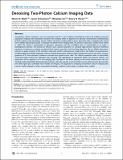| dc.contributor.author | Schummers, James | |
| dc.contributor.author | Sur, Mriganka | |
| dc.contributor.author | Perc, Matjaz | |
| dc.contributor.author | Malik, Wasim | |
| dc.contributor.author | Brown, Emery Neal | |
| dc.date.accessioned | 2011-12-30T02:05:51Z | |
| dc.date.issued | 2011 | |
| dc.identifier.citation | Malik, Wasim Q., James Schummers, Mriganka Sur, and Emery N. Brown. 2011. Denoising two-photon calcium imaging data. PLoS ONE 6(6): e20490. | en_US |
| dc.identifier.issn | 1932-6203 | en_US |
| dc.identifier.uri | http://nrs.harvard.edu/urn-3:HUL.InstRepos:5978715 | |
| dc.description.abstract | Two-photon calcium imaging is now an important tool for in vivo imaging of biological systems. By enabling neuronal population imaging with subcellular resolution, this modality offers an approach for gaining a fundamental understanding of brain anatomy and physiology. Proper analysis of calcium imaging data requires denoising, that is separating the signal from complex physiological noise. To analyze two-photon brain imaging data, we present a signal plus colored noise model in which the signal is represented as harmonic regression and the correlated noise is represented as an order autoregressive process. We provide an efficient cyclic descent algorithm to compute approximate maximum likelihood parameter estimates by combing a weighted least-squares procedure with the Burg algorithm. We use Akaike information criterion to guide selection of the harmonic regression and the autoregressive model orders. Our flexible yet parsimonious modeling approach reliably separates stimulus-evoked fluorescence response from background activity and noise, assesses goodness of fit, and estimates confidence intervals and signal-to-noise ratio. This refined separation leads to appreciably enhanced image contrast for individual cells including clear delineation of subcellular details and network activity. The application of our approach to in vivo imaging data recorded in the ferret primary visual cortex demonstrates that our method yields substantially denoised signal estimates. We also provide a general Volterra series framework for deriving this and other signal plus correlated noise models for imaging. This approach to analyzing two-photon calcium imaging data may be readily adapted to other computational biology problems which apply correlated noise models. | en_US |
| dc.language.iso | en_US | en_US |
| dc.publisher | Public Library of Science | en_US |
| dc.relation.isversionof | 10.1371/journal.pone.0020490 | en_US |
| dc.relation.hasversion | http://www.ncbi.nlm.nih.gov/pmc/articles/PMC3110192/pdf/ | en_US |
| dash.license | LAA | |
| dc.title | Denoising Two-Photon Calcium Imaging Data | en_US |
| dc.type | Journal Article | en_US |
| dc.description.version | Version of Record | en_US |
| dc.relation.journal | PLoS ONE | en_US |
| dash.depositing.author | Brown, Emery Neal | |
| dc.date.available | 2011-12-30T02:05:51Z | |
| dash.affiliation.other | 100164 | en_US |
| dc.identifier.doi | 10.1371/journal.pone.0020490 | * |
| dash.authorsordered | false | |
| dash.contributor.affiliated | Malik, Wasim | |
| dash.contributor.affiliated | Brown, Emery | |


